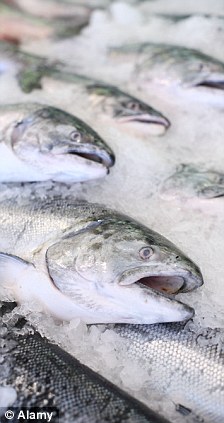澳大利亚和英国研究人员发现,摄入蛋白质过少,即蛋白质占热量来源比例低于15%时,人容易产生饥饿感,导致吃更多零食、摄入额外热量,不利保持健康体重。
澳大利亚悉尼大学和英国剑桥大学研究人员征募22名志愿者,男女皆有,体重正常,年龄介于18岁至51岁间。研究人员让他们在实验室食用三餐,包括相同的正餐和可自选的零食。譬如早餐为松饼,午餐是烤金枪鱼和沙拉,晚餐是牛肉面或肉酱意大利面、蔬菜和一道甜点。


一餐热量中,30%来自脂肪,其余来自碳水化合物和蛋白质,前四天10%的热量来自蛋白质,随后四天15%的热量来自蛋白质,最后四天增为20%。实验期间,志愿者每天从事相同运动和其他活动,避免因无聊或压力进食。
志愿者说,前四天早餐后两小时饥饿感甚于后面8天,后面8天饥饿感相同。因此,志愿者在前四天选用零食较多,多摄入热量1036卡路里。如果不进行额外锻炼,照此计算,一个月可能增重1公斤左右。
这一研究结果12日由美国《科学公共图书馆综合卷》发表。
英国《每日邮报》援引报告主要作者、悉尼大学艾利森·格洛斯比的话报道:“结果显示,人们对蛋白质的食欲相当强,当食物中蛋白质比例偏低,这种食欲能够促使人摄入额外热量。”
报告作者之一、悉尼大学的史蒂夫·辛普森说,蛋白质由氨基酸组成,游离氨基酸的循环对控制食欲发挥着重要作用,体内很多地方,包括大脑某些部位的氨基酸受体参与控制进食和产生饥饿感。至于氨基酸如何作用于大脑抑制食欲还有待进一步研究。
营养学家建议减肥人士合理安排膳食结构,大致可以四分之一为蛋白质,四分之一为碳水化合物,一半为蔬菜。
英国成年人饮食中,蛋白质所占比例平均为12%,不少人由于食用加工食品而摄入大量碳水化合物,减少了热量来源中蛋白质的比例。
研究报告作者之一、剑桥大学营养研究小组负责人苏珊·杰布说,食用大量碳水化合物和脂肪,譬如碳酸饮料是致胖的主要因素之一,它们“稀释”了人们摄取的蛋白质。
“我们建议适量增加(蛋白质),但也不提倡食用大量蛋白质或完全不吃碳水化合物,”杰布说,“研究结果应用于现实世界中就是,摄取15%的蛋白质足以避免热量摄入过量,有助减重。”
相关英文论文摘要:
Testing Protein Leverage in Lean Humans: A Randomised Controlled Experimental Study
A significant contributor to the rising rates of human obesity is an increase in energy intake. The ‘protein leverage hypothesis’ proposes that a dominant appetite for protein in conjunction with a decline in the ratio of protein to fat and carbohydrate in the diet drives excess energy intake and could therefore promote the development of obesity. Our aim was to test the ‘protein leverage hypothesis’ in lean humans by disguising the macronutrient composition of foods offered to subjects under ad libitum feeding conditions. Energy intakes and hunger ratings were measured for 22 lean subjects studied over three 4-day periods of in-house dietary manipulation. Subjects were restricted to fixed menus in random order comprising 28 foods designed to be similar in palatability, availability, variety and sensory quality and providing 10%, 15% or 25% energy as protein. Nutrient and energy intake was calculated as the product of the amount of each food eaten and its composition. Lowering the percent protein of the diet from 15% to 10% resulted in higher (+12±4.5%, p = 0.02) total energy intake, predominantly from savoury-flavoured foods available between meals. This increased energy intake was not sufficient to maintain protein intake constant, indicating that protein leverage is incomplete. Urinary urea on the 10% and 15% protein diets did not differ statistically, nor did they differ from habitual values prior to the study. In contrast, increasing protein from 15% to 25% did not alter energy intake. On the fourth day of the trial, however, there was a greater increase in the hunger score between 1–2 h after the 10% protein breakfast versus the 25% protein breakfast (1.6±0.4 vs 25%: 0.5±0.3, p = 0.005). In our study population a change in the nutritional environment that dilutes dietary protein with carbohydrate and fat promotes overconsumption, enhancing the risk for potential weight gain.
英文论文链接:https://www.biodiscover.com/news/hotspot/library/1464







